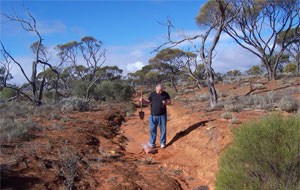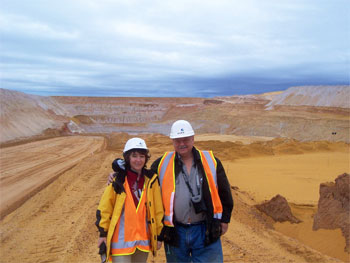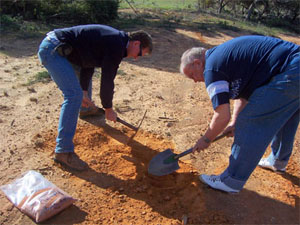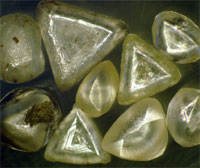Industry interaction
INDUSTRY INTERACTION, TECHNOLOGY TRANSFER AND COMMERCIALISATION PROGRAM
GEMOC relies on a vigorous interaction with the mineral exploration industry at both the research and the teaching/training levels. The research results of the Centre’s work are transferred to the industry and to the scientific community by:
• collaborative industry-supported Honours, MSc and PhD projects
• short courses relevant to the industry and government sector users, designed to communicate and transfer new technologies, techniques and knowledge in the discipline areas covered by the Key Centre
• one-on-one research collaborations and shorter-term collaborative research on industry problems involving national and international partners
• provision of high quality geochemical analyses with value-added interpretations in collaboration with industry and government organisations, extending our industry interface
• use of AccessMQ consultancies and collaborative industry projects, which employ and disseminate the technological developments carried out by the Centre
• GLITTER, an on-line data-reduction program for Laser Ablation ICPMS analysis, developed by GEMOC and CSIRO GEMOC participants, has been successfully commercialised and is available from GEMOC through AccessMQ (http://www.es.mq.edu.au/GEMOC/); the software is continuously upgraded
• collaborative relationships with technology manufacturers (more detail in the section on Technology Development)
• GEMOC (Macquarie) is the Australian demonstration site for Agilent Technologies LAM-ICPMS applications
• GEMOC (Macquarie) is an international test site for New Wave Research Lasers
SUPPORT SOURCES
GEMOC industry support includes:
• direct funding of research programs
• "in kind" funding including field support (Australia and overseas), access to proprietary databases, sample collections, digital datasets and support for GIS platforms
• logistic support for fieldwork for postgraduate projects
• collaborative research programs through ARC Linkage Projects and the Macquarie University External Collaborative Grants (MUECRG) and PhD program support
• assistance in the implementation of GIS technology in postgraduate programs
• participation of industry colleagues as guest lecturers in undergraduate units
• extended visits to Macquarie by industry personnel for interaction and research
• ongoing informal provision of advice and formal input as members of the Advisory Board
ACTIVITIES IN 2008
10 Industry Reports were completed for collaborative industry projects.
TerraneChron® studies (see Research Highlights) have enjoyed continued uptake by a significant segment of the global mineral exploration industry. This methodology, currently unique to GEMOC, requires the integration of data from three instruments (electron microprobe, LAM-ICPMS and LAM-MC-ICPMS) and delivers fast, cost-effective information on the tectonic history (with ages) of regional terranes (www.es.mq.edu.a cvfu/GEMOC/TerraneChron.html).
The ARC Linkage Project titled “Global Lithosphere Architecture Mapping” (GLAM) continued with full industry partner support following the takeover of WMC Resources by BHP Billiton. Planning and workshop sessions at Macquarie with participants from BHP Billiton and GEMOC, and visits by Macquarie researchers to Perth, were key activities in 2008,  following a successful application for a new 3-year Linkage Project. Dr Graham Begg spent significant research time at GEMOC through 2008 as part of the close collaborative working pattern for this project. Sub-licencing agreement was executed with Minerals Targeting International to accommodate Dr Begg’s new role (in relationship to Macquarie, BHPB, and the GLAM project) as Director of this company.
following a successful application for a new 3-year Linkage Project. Dr Graham Begg spent significant research time at GEMOC through 2008 as part of the close collaborative working pattern for this project. Sub-licencing agreement was executed with Minerals Targeting International to accommodate Dr Begg’s new role (in relationship to Macquarie, BHPB, and the GLAM project) as Director of this company.
BHP Billiton staff visited for several days to discuss results from the ARC Linkage Project (see GLAM Research Highlight), and plan for the future. Back row (L-R): Elena Belousova, Sue O’Reilly, Norm Pearson, Nick Haywood, Craig O’Neill, Lev Natapov, Graham Begg and Bill Griffin.
GEMOC’s development of a method to analyse trace elements in diamond has opened up potential further developments and applications relevant to industry, ranging from diamond fingerprinting for a range of purposes to improving the knowledge framework for diamond exploration. Rio Tinto continued to support an ARC Linkage Project on Diamond Fingerprinting. Dr Debora Araujo has been employed as a Research Associate on the project and has carried out an extensive program of method development and diamond analysis.
In 2007-2008 GEMOC developed a technique for dating the intrusion of kimberlites and lamproites using LAM-ICPMS U-Pb analysis of groundmass perovskite (see GEMOC Publication #505). This rapid, low-cost application has proven very attractive to the diamond exploration industry, and has led to several small collaborative projects; it also will be applied in the new ARC Linkage project sponsored by De Beers.
During 2008, GEMOC increased its collaboration with CERCAMS, the Centre for Russian and Central EurAsian Mineral Studies at the Natural History Museum, London, that serves the international mineral deposits community as a centre for research into the geodynamics and metallogenesis of the Former Soviet Union and neighbouring territories.
A continuing collaborative research relationship with New South Wales Geological Survey is applying TerraneChron® to investigations of the provenance of targeted sequences in Paleozoic sedimentary terranes of eastern Australia, and the development of the Macquarie Arc.
Industry visitors spent varying periods at GEMOC in 2008 to discuss our research and technology development (see visitor list, Appendix 3). This face-to-face interaction has proved highly effective both for GEMOC researchers and industry colleagues.
DIATREEM continued to provide LAM-ICPMS analyses of garnets and chromites to the diamond-exploration industry on a collaborative basis.
GEMOC publications, preprints and non-proprietary reports are available on request for industry libraries.
GEMOC was prominent in delivering keynote and invited talks and workshop modules at national and international industry peak conferences in 2008. Sue O’Reilly has been a member of the organising committee for the SGA Conference in Townsville in 2009. See Appendix 4 for abstract titles and GEMOC Publications.
A new ARC Linkage project was awarded with de Beers as Industry Partner (see below).



Elena Belousova, Steven Cooper and Prof Alexandr Kremenetsky from Institute of Mineralogy, Geochemistry and Crystal Chemistry of Rare Elements (IMGRE) collecting samples of mineral sands in SA and WA.
A new collaborative research project aimed at developing an integrated approach to understanding the formation of the mineral sand deposits using Australian deposits as a world benchmark, and to improve exploration strategies employed in Australia and in Russia was initiated in collaboration with Professor Alexandr Kremenetsky from Institute of Mineralogy, Geochemistry and Crystal Chemistry of Rare Elements (IMGRE), PIRSA and Iluka Resources.
CURRENT INDUSTRY-FUNDED COLLABORATIVE RESEARCH POJECTS
These are brief descriptions of current gemoc projects that have direct cash support from industry with either formal ARC or Macquarie University Grant status, and timeframes of at least one year. Projects are both national and global. In addition to these formal projects, many shorter projects are directly funded by industry alone, and the results of these feed into our basic research database (with varied confidentiality considerations). Such projects are administered by AccessMQ, Macquarie’s commercial entity.
GEMOC’s industry collaborative projects are designed to develop the strategic and applied aspects of the basic research programs based on understanding the architecture of the lithosphere and the nature of Earth’s geodynamic processes that have controlled the evolution of the lithosphere and its important discontinuities. Most of the industry collaborative projects rely on geochemical information from the Geochemical Analysis Unit in GEMOC and especially on novel methodologies developed by (and some unique to) GEMOC.
Geochemical data on crustal and mantle rocks are being integrated with tectonic analyses and large-scale datasets (including geophysical data) to understand the relationship between lithosphere domains and large-scale mineralisation.
The use of mantle sulfides to date mantle events, and the characterisation of crustal terrane development using U-Pb dating and Hf isotopic compositions of zircons provide more information for integration with geophysical modelling. TerraneChron® (see Research Highlights) is an important tool for characterising the tectonic history and crustal evolution of terranes on the scale of 10 – 100 km and delivers a cost-effective exploration tool to the mineral (and potentially petroleum) exploration industry.
The recent breakthrough in developing a robust methodology to analyse the trace elements in diamonds quantitatively is another world-first for GEMOC. In addition to providing unique knowledge about the nature and compositions of deep mantle fluids that has led to a new hypothesis for how diamonds form in the Earth’s mantle (see Research Highlights 2007, p. 27, 30), it has potential practical applications to diamond fingerprinting for forensic applications and to better prediction of targets for diamond exploration.
Formal projects known to be funded for 2009:
|
Formal projects commencing 2008:
|
|
|
Lithosphere evolution across a craton margin, southern AfricaSupported by Industry and a matching Macquarie University Collaborative Grant Summary: The margins of cratonic blocks extend to 150-300 km depth, and exert a strong control on crustal tectonics. Kimberlite magmas intruded across the southern margin of the Kaapvaal Craton (S. Africa) provide detailed sampling of the lithospheric mantle. We will use these samples to map the composition and structure of the mantle in two time slices (120 Ma, 90 Ma), providing new information on how the craton margins channel fluids. Linkages between crustal tectonics and mantle events are being constrained by comparing TerraneChron® analysis of zircons from modern streams, and the kimberlites themselves, with existing Re-Os ages for mantle rocks. |
Trace-element Analysis of DiamondsSupported by Industry and a matching Macquarie University Collaborative Grant Industry Collaborator: Rio Tinto Summary: Diamonds contain minute amounts of trapped fluids, representing the medium from which the diamonds grew; these fluids are a unique source of information on processes in Earth’s mantle. New techniques for the trace-element analysis of these fluids, developed recently in GEMOC were further developed, and applied to the analysis of selected populations of diamonds from the Argyle mine (WA). The data will provide new insights into the genesis of diamond, with applications both to exploration models and to test the feasibility of “fingerprinting” of diamonds for exploration and forensic purposes (tracing illegal diamond sources). This project led to the ARC Linkage Grant for 2007. |
|
|

 GEMOC ARC National Key Centre
GEMOC ARC National Key Centre



